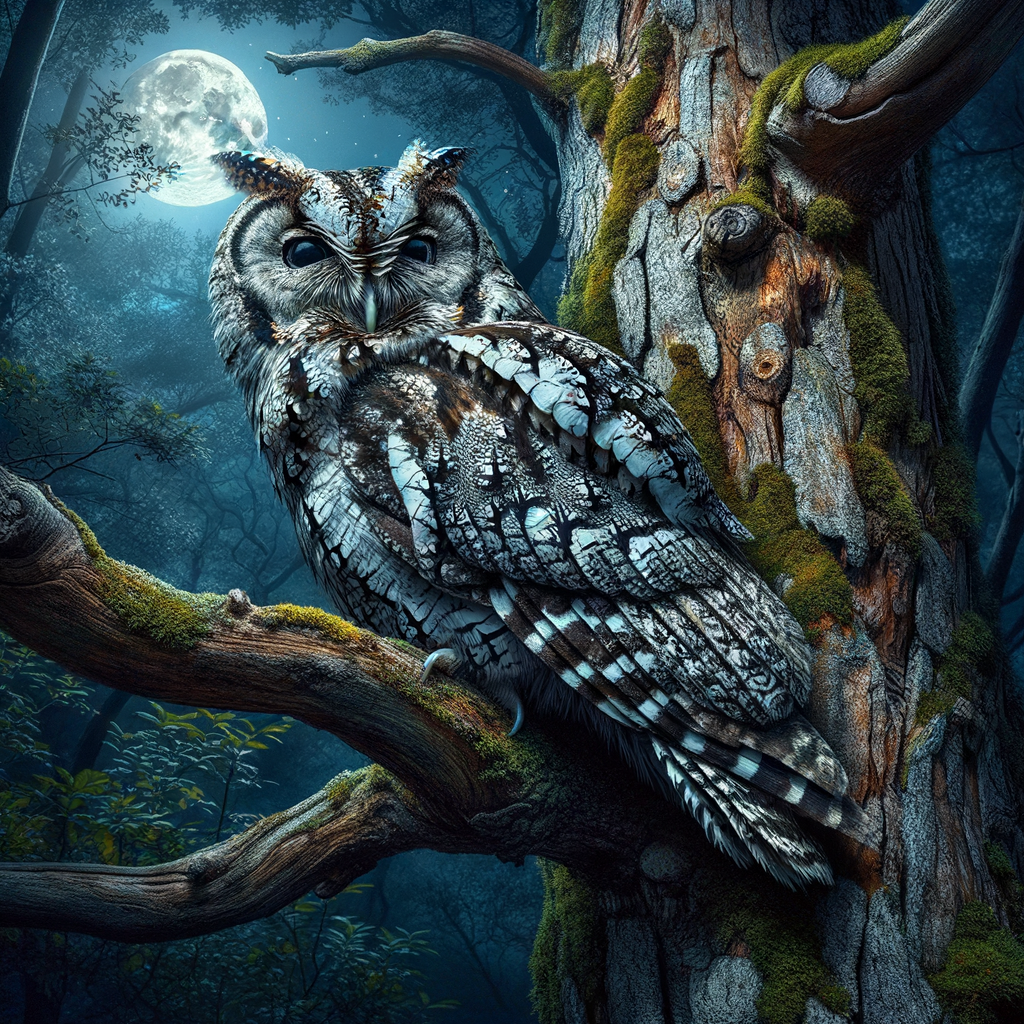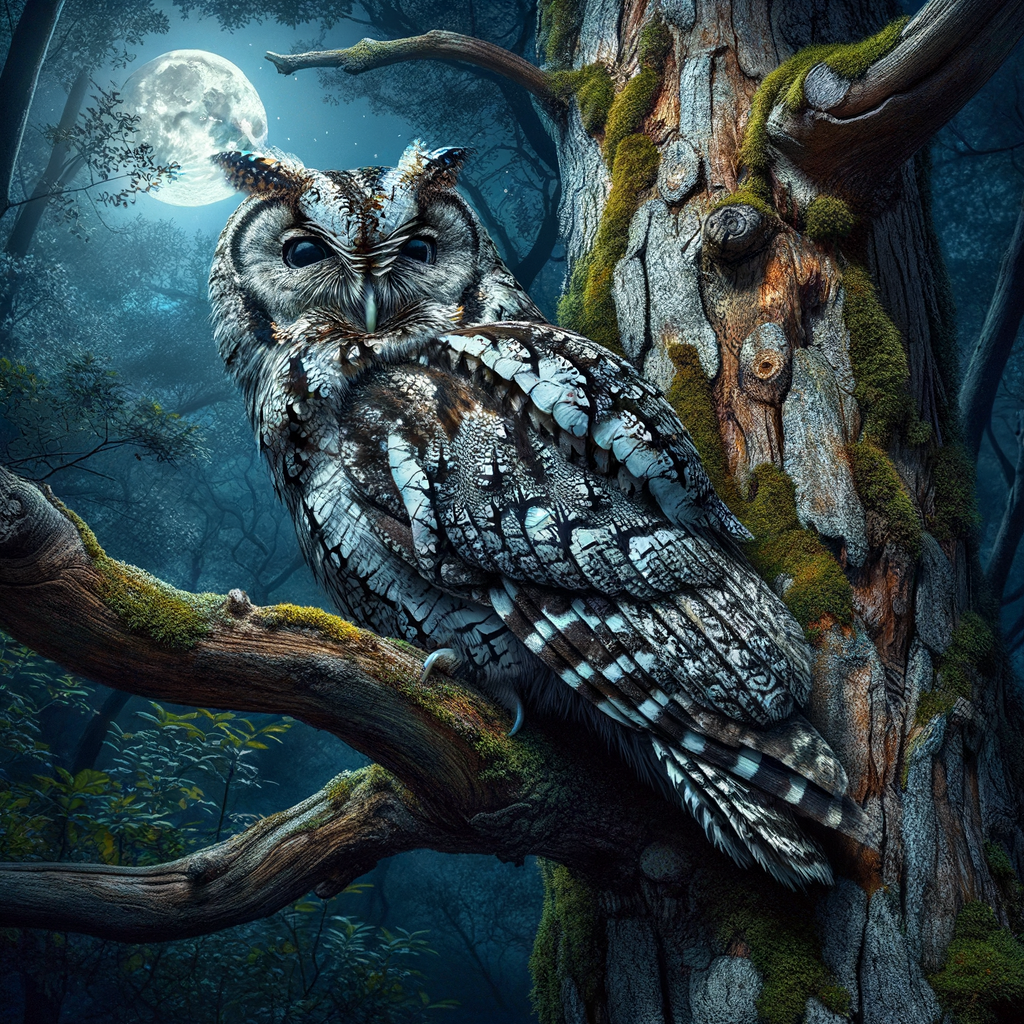
Introduction to Owl Camouflage
- The importance of camouflage in the animal kingdom:
Camouflage is a vital survival tool for many animals. It helps them hide from predators and sneak up on prey. In nature, being unseen can mean the difference between life and death. For example, a lion’s tawny coat blends with the dry grasslands, making it hard for prey to spot them. - Overview of owl camouflage techniques:
Owls are masters of disguise. Their feathers often match the colors and patterns of their surroundings. This makes it hard for both predators and prey to see them. Some owls look like tree bark, while others blend with leaves. This clever camouflage helps them stay safe and catch food.
Owl Camouflage Techniques
Overview of Techniques
Owls are masters of disguise. They use different techniques to hide from predators and sneak up on prey. Let’s look at three main techniques they use:
- Feather Camouflage: Owls have special feathers that help them blend in with their surroundings. These feathers can look like tree bark, leaves, or even snow.
- Habitat Camouflage: They choose habitats that match their feather colors. For example, a snowy owl lives in snowy areas, while a brown owl might live in a forest.
- Blending with the Environment: Use their surroundings to hide. They stay still and quiet, making it hard for others to see them.
Each of these techniques helps owls stay safe and catch food. Let’s explore each one in more detail.
Owl Feather Camouflage
- How owls use their feathers for camouflage:Owls have special feathers that help them blend into their surroundings. These feathers have colors and patterns that match the trees, leaves, and ground where they live. This makes it hard for other animals to see them.
For example, the Great Horned Owl has brown and gray feathers. These colors look like tree bark. When the owl sits still, it looks like part of the tree.
-
Examples of owl feather camouflage patterns:
Owl Species Camouflage Pattern Eastern Screech Owl Gray and brown feathers that look like tree bark Snowy Owl White feathers that blend with snow Barn Owl Pale feathers that match the light color of barns and fields These patterns help owls hide from predators and sneak up on their prey. For instance, the Snowy Owl’s white feathers make it almost invisible in snowy environments.
Owl Habitat Camouflage
- How owls use their habitat for camouflage:They choose places that match their feathers. This helps them blend in and stay safe from predators. For example, an owl with brown feathers might live in a forest with lots of trees and leaves. This makes it hard for others to see them.
- Examples of owl habitat camouflage patterns:The Great Horned Owl often lives in dense forests. Its brown and white feathers look like tree bark. The Snowy Owl, with its white feathers, lives in snowy areas. This makes it almost invisible in the snow. Another example is the Barn Owl. It has light-colored feathers and often hides in barns or old buildings. This helps it blend in with the surroundings.
Owl Blending with Environment
-
How owls blend with their environment for camouflage:
Owls are masters of disguise. They use their colors and patterns to blend into their surroundings. This helps them hide from predators and sneak up on their prey. Owls can look like tree bark, leaves, or even snow, depending on where they live.
-
Examples of owls blending with their environment:
- Eastern Screech Owl: This owl has gray or reddish-brown feathers. It blends in perfectly with tree bark. When it sits still, it looks just like part of the tree.
- Snowy Owl: Found in the Arctic, this owl has white feathers. It blends in with the snow and ice. This makes it hard for predators to see it.
- Great Horned Owl: This owl has mottled brown and gray feathers. It can blend in with the forest floor or tree branches. This helps it stay hidden while hunting.
Owl Survival Tactics
Owl Predator Evasion
-
How Owls Use Camouflage for Predator Evasion
Owls are masters of disguise. They use their feathers to blend into their surroundings. This is called camouflage. By looking like tree bark or leaves, owls can hide from predators like hawks and eagles.
For example, the Eastern Screech Owl has gray and brown feathers. These colors help it blend into tree trunks. When it sits still, it is very hard to see.
-
Case Studies of Owl Predator Evasion
Let’s look at some real-life examples:
Owl Species Camouflage Technique Predator Eastern Screech Owl Blends into tree bark Hawks Snowy Owl White feathers match snow Foxes Great Horned Owl Brown feathers blend with forest Eagles In one case, a Snowy Owl evaded a fox by sitting still in the snow. Its white feathers made it invisible. The fox walked right past it!
Owl Hiding Strategies
- How Owls Use Hiding Strategies for Survival
Owls are masters of hiding. They use their surroundings to blend in and stay safe. This helps them avoid predators and catch prey. By hiding well, owls can live longer and healthier lives.
One way owls hide is by using their feathers. Their feathers often match the colors of trees and leaves. This makes it hard for other animals to see them. Owls also stay very still, which helps them stay hidden.
- Examples of Owl Hiding Strategies
Here are some examples of how owls hide:
- Eastern Screech Owl: This owl has gray or red feathers. It looks like tree bark. When it sits on a tree, it is almost invisible.
- Snowy Owl: This owl lives in snowy places. Its white feathers help it blend in with the snow. This makes it hard for predators to spot it.
- Great Horned Owl: This owl uses its ear tufts to look like branches. It also sits very still, making it hard to see.
| Owl Species | Hiding Strategy |
|---|---|
| Eastern Screech Owl | Blends with tree bark |
| Snowy Owl | Blends with snow |
| Great Horned Owl | Uses ear tufts to look like branches |
Conclusion: The Art of Owl Camouflage
- Summary of Owl Camouflage TechniquesOwls use their feathers to blend into their surroundings. Their colors and patterns match the trees and leaves where they live. Some owls even change their colors with the seasons. They stay still and silent to avoid being seen by predators and prey.
-
Key Takeaways About Owl Camouflage
- Owls have special feathers that help them blend in.
- They use colors and patterns to match their environment.
- Staying still and quiet helps them stay hidden.
- Some owls can change their colors with the seasons.
| Owl Camouflage Technique | Description |
|---|---|
| Feather Colors | Match the environment, like trees and leaves. |
| Patterns | Blend in with surroundings to avoid detection. |
| Stillness | Stay motionless to avoid being seen. |
| Seasonal Change | Some owls change colors with the seasons. |
Understanding these techniques helps us appreciate how owls survive in the wild. Their camouflage is a true art form, perfected over time.






